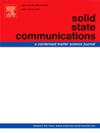The boson-defined thermodynamics at the liquid-solid transition
IF 2.1
4区 物理与天体物理
Q3 PHYSICS, CONDENSED MATTER
引用次数: 0
Abstract
Experimental evidence from rare gas (RG) solids, Ne, Ar, Kr and Xe, shows that a boson field orders at the liquid-solid transition. Upon ordering, all bosons condense in the lowest energy state (Bose-Einstein condensation). This is the highest possible thermodynamic order and provides an entropy argument for the surprising exclusion of the interatomic van der Waals interactions from performing the liquid-solid transition. Since the ordered boson field interacts with the atomic system, it defines the observed long-range coherent order of the crystalline state. This order is more perfect than can be expected if the locally anisotropic interatomic interactions would cause the ordering transition. Boson dynamics is evidenced by the observed universal temperature dependence of heat capacity and thermal length changes, ΔL/L0, in the critical range below the melting temperature, Tm. It is argued that the bosons are elastic quadrupole radiation. Upon ordering, boson fields confine themselves to the finite volume of a stationary unit, such as a domain or a mosaic block, and compress the ordered unit increasingly with decreasing temperature. This compression ensures the cohesion of the solids up to Tm. The low-temperature lattice parameters, therefore, are rather short and the calculated van der Waals cohesive energies are larger by a factor of ten compared to the melting temperatures, Tm. In analogy to the term magnetostriction, the thermal lattice contractions below Tm could be termed “elastostriction”.
玻色子定义的液固跃迁热力学
来自稀有气体(RG)固体(Ne, Ar, Kr和Xe)的实验证据表明,玻色子场在液固跃迁时有序。排序后,所有玻色子都以最低能态(玻色-爱因斯坦凝聚)凝聚。这是最高可能的热力学阶,并为原子间范德华相互作用令人惊讶地排除在液固转变之外提供了熵的论据。由于有序玻色子场与原子系统相互作用,它定义了观察到的晶体状态的长程相干有序。这种顺序比局部各向异性原子间相互作用引起的顺序跃迁更为完美。在熔点Tm以下的临界范围内,热容量和热长度变化(ΔL/L0)对温度的普遍依赖证明了玻色子动力学。认为玻色子是弹性四极辐射。在有序时,玻色子场将自己限制在固定单元的有限体积内,如一个域或马赛克块,并随着温度的降低而压缩有序单元。这种压缩保证了固体的内聚力达到Tm。因此,低温晶格参数相当短,计算出的范德瓦尔斯内聚能比熔化温度Tm大十倍。与磁致伸缩类似,Tm以下的热晶格收缩可以称为“弹性伸缩”。
本文章由计算机程序翻译,如有差异,请以英文原文为准。
求助全文
约1分钟内获得全文
求助全文
来源期刊

Solid State Communications
物理-物理:凝聚态物理
CiteScore
3.40
自引率
4.80%
发文量
287
审稿时长
51 days
期刊介绍:
Solid State Communications is an international medium for the publication of short communications and original research articles on significant developments in condensed matter science, giving scientists immediate access to important, recently completed work. The journal publishes original experimental and theoretical research on the physical and chemical properties of solids and other condensed systems and also on their preparation. The submission of manuscripts reporting research on the basic physics of materials science and devices, as well as of state-of-the-art microstructures and nanostructures, is encouraged.
A coherent quantitative treatment emphasizing new physics is expected rather than a simple accumulation of experimental data. Consistent with these aims, the short communications should be kept concise and short, usually not longer than six printed pages. The number of figures and tables should also be kept to a minimum. Solid State Communications now also welcomes original research articles without length restrictions.
The Fast-Track section of Solid State Communications is the venue for very rapid publication of short communications on significant developments in condensed matter science. The goal is to offer the broad condensed matter community quick and immediate access to publish recently completed papers in research areas that are rapidly evolving and in which there are developments with great potential impact.
 求助内容:
求助内容: 应助结果提醒方式:
应助结果提醒方式:


